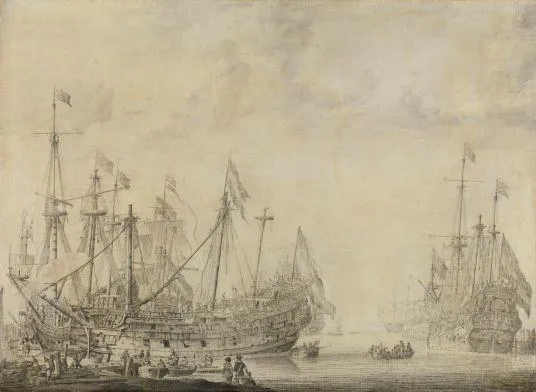Witte de With: a Dutch naval hero with a tainted name

Witte Cornelis de With (1599-1658) is the subject of heated debate. For centuries, he was seen as one of the greatest naval heroes in Dutch history. Today, though, we can also see the other side: the fact that his victories were built on oppression and colonial violence. A hero to some, ‘the worst kind of ruffian’ to others, Witte de With was also imprisoned in the Prison Gate in the mid-seventeenth century.
Hated and feared by many
Born in Den Briel, Witte de With made his name as vice-admiral of the Dutch fleet in the seventeenth century. At the age of sixteen, he was already sailing the world. Like many other naval heroes, he began his career as a ship’s boy in the service of the Dutch East India Company. Together with Piet Heyn, he captured the Spanish treasure-fleet in 1628. He was known as an extremely talented seaman, but also as an ambitious, jealous, quarrelsome and tough man.

Imprisoned in the Knight’s Chamber
Whilst in the service of the Dutch West India Company, from 1648, he led a military fleet to Brazil, then a Dutch colony threatened by the Portuguese. In 1650, when De With was returning to the Republic, fleet and all, it was found that the provisioning of his ship to Brazil had been defective. Although Witte de With protested his innocence, in a letter, the Dutch Council of Brazil argued that he was guilty of a dereliction of duty, punishable by execution. Carried in a swift mail ship, the letter reached The Hague before he did.
'When Witte de With presented himself in The Hague to make his report, he was immediately imprisoned in the Knight’s Chamber in the Prison Gate.'
A long court case followed. As he promised not to flee, De With was eventually permitted to serve his sentence at home.
A light punishment
Finally sentenced in February 1651, Witte de With was found guilty of dereliction of duty. He came off lightly, however: he had to pay the legal costs and a fine. All in all, this came to around 7,000 guilders, an astronomical sum at the time. After this, De With re-entered the service of the Dutch fleet. In 1658, he sailed with a squadron to the Baltic Sea to aid Denmark in a war against Sweden. When his ship was boarded, Witte de With kept fighting until he fell. His body was taken via Sweden and Denmark to Rotterdam, where he was buried in the Grote Kerk. At that time, he was a symbol of Dutch national pride and guardian of the Republic’s colonial possessions. History’s pendulum can swing the other way, however, and these days Witte de With is increasingly seen as a flawed naval hero.

